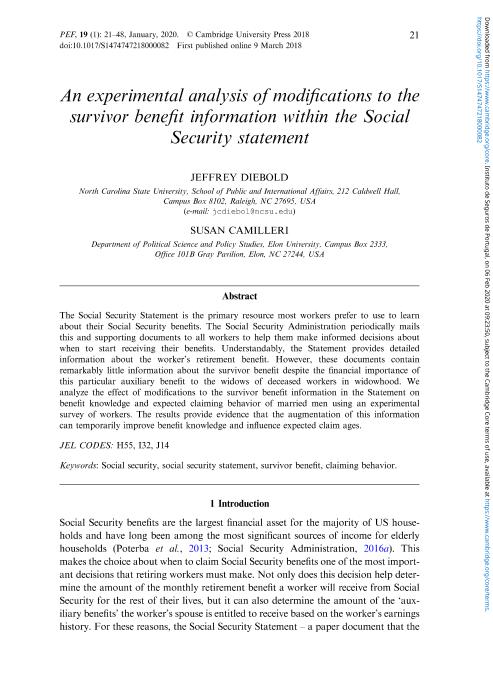An Experimental analysis of modifications to the survivor benefit information within the Social Security statement

Contenido multimedia no disponible por derechos de autor o por acceso restringido. Contacte con la institución para más información.
| Tag | 1 | 2 | Valor |
|---|---|---|---|
| LDR | 00000cab a22000004b 4500 | ||
| 001 | MAP20200003953 | ||
| 003 | MAP | ||
| 005 | 20220912093100.0 | ||
| 008 | 200211e2020 gbr|| p |0|||b|eng d | ||
| 040 | $aMAP$beng$dMAP | ||
| 084 | $a40 | ||
| 100 | 1 | $0MAPA20200002772$aDiebold, Jeffrey | |
| 245 | 1 | 3 | $aAn Experimental analysis of modifications to the survivor benefit information within the Social Security statement$cJeffrey Diebold and Susan Camilleri |
| 520 | $aThe Social Security Statement is the primary resource most workers prefer to use to learn about their Social Security benfits. The Social Security Administration periodically mails this and supporting documents to all workers to help them make informed decisions about when to start receiving their benefits. Understandably, the Statement provides detailed information about the worker's retirement benefit. However, these documents contain remarkably little information about the survivor benefit despite the financial importance of this particular auxiliary benefit to the widows of deceased workers in widowhood. We analyze the effect of modifications to the survivor benefit information in the Statement on benefit knowledge and expected claiming behavior of married men using an experimental survey of workers. The results provide evidence that the augmentation of this information can temporarily improve benefit knowledge and influence expected claim ages. | ||
| 650 | 4 | $0MAPA20080578107$aSeguridad Social | |
| 650 | 4 | $0MAPA20080606299$aFuentes de información | |
| 650 | 4 | $0MAPA20080650193$aInformación al cliente | |
| 650 | 4 | $0MAPA20080604714$aAnálisis de resultados | |
| 650 | 4 | $0MAPA20080564445$aTrabajadores | |
| 650 | 4 | $0MAPA20080592332$aPensión de viudedad | |
| 650 | 4 | $0MAPA20080572778$aMejora continua | |
| 700 | 1 | $0MAPA20200002789$aCamilleri, Susan | |
| 710 | 2 | $0MAPA20200002796$aCambridge University Press | |
| 773 | 0 | $tJournal of Pension Economics & Finance.- London : Cambridge University Press $gnº 19; January 2020, p. 21-48 |

